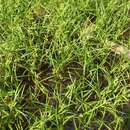Comments
(
anglais
)
fourni par eFloras
Carex schweinitzii is very local and uncommon but often forms large colonies where present. It hybridizes occasionally with C. hystericina. The single, old Missouri collection (G. Yatskievych 1999+) seems so far disjunct as to suggest that there may have been a label mixup.
- licence
- cc-by-nc-sa-3.0
- droit d’auteur
- Missouri Botanical Garden, 4344 Shaw Boulevard, St. Louis, MO, 63110 USA
Description
(
anglais
)
fourni par eFloras
Plants extensively colonial; rhizomes long. Culms trigonous in cross section, 18–65 cm, smooth distally. Leaves: basal sheaths pale brown; ligules as wide to wider than long; blades pale to mid green, flat to W-shaped, 4–11 mm wide, glabrous. Inflorescences 8–24 cm; proximal bract 11–37 cm, exceeding inflorescence; proximal 2–4 spikes pistillate, erect or often the proximal ascending to spreading; terminal 1(–2) spikes staminate. Pistillate scales lanceolate-acuminate, 2.4–6.9 × 0.3–0.9 mm, shorter than or the proximal longer than perigynia, margins serrulate-ciliate, apex with prominent scabrous awn. Staminate scales acute to acuminate, smooth except at tip. Perigynia ascending, 7–11-veined, narrowly elliptic, 4.2–7 × 1.3–1.8 mm, apex tapered; beak 1.4–2.4 mm, bidentulate, smooth, teeth straight, 0.2–0.5 mm. Stigmas 3. Achenes pale brown, trigonous, smooth.
- licence
- cc-by-nc-sa-3.0
- droit d’auteur
- Missouri Botanical Garden, 4344 Shaw Boulevard, St. Louis, MO, 63110 USA
Distribution
(
anglais
)
fourni par eFloras
Ont.; Conn., Mass., Mich., Mo., N.Y., Pa., Vt., Va., Wis.
- licence
- cc-by-nc-sa-3.0
- droit d’auteur
- Missouri Botanical Garden, 4344 Shaw Boulevard, St. Louis, MO, 63110 USA
Habitat
(
anglais
)
fourni par eFloras
Shallow cold streams, springheads, seeps, margins of fens, and seepy stream, pond, and lakeshores in open or lightly shaded sites, in highly calcareous soils; 100–600m.
- licence
- cc-by-nc-sa-3.0
- droit d’auteur
- Missouri Botanical Garden, 4344 Shaw Boulevard, St. Louis, MO, 63110 USA
Comprehensive Description
(
anglais
)
fourni par North American Flora
Carex schweinitzii Dewey; Schw. Ann. Lye. N. Y. 1 : 71. 1824
"Carex Schweinitzia Dewey" Eaton, Man. ed. 5. 159. 1829. (Change of form of name.)
Loosely cespitose and stoloniferous, the stolons numerous, long, horizontal, slender, tough, the culms 2.5-7.5 dm. high, stoutish, stiff, erect, exceeded by the bracts and often by the upper leaves, aphyllopodic, sharply triangular and smooth to very rough above, light-brownishtinged at base, the dried-up leaves of the previous year conspicuous; leaves with well-developed blades 3-7 to a fertile culm, not clustered, septate-nodulose, the blades yellowish-green or light-green, thinnish, stiff, fiat with slightly revolute margins, usually 2-3 dm. long, 5-10 mm. wide, rough toward the apex, the sheaths rather loose, white-hyaline ventrally, truncate at mouth, the ligule short, wider than long; staminate spike solitary, erect, slender-peduncled, usually with a conspicuous bract or a smaller sessile spike some distance below, 2.5 cm. long, 2.5 mm. wide, the scales oblong-obovate or oblanceolate, little ciliate, cuspidate or acute, light-reddish-brown-tinged with green midrib and very narrow hyaline margins; pistillate spikes 2-5, approximate to strongly separate, the lower on short or occasionally long peduncles, erect or somewhat recurving-spreading, the upper erect on short peduncles or nearly sessile, the peduncles slender, rough, the spikes narrowly cylindric, 2.5-9 cm. long, 8-14 mm. wide, closely flowered above, more loosely below r , containing numerous spreading or somewhat ascending perigynia in several rows, the spikes occasionally somewhat compound at base; lower bracts leaf-like, exceeding inflorescence, more or less strongly sheathing, the upper reduced; scales with short, oblong-ovate, non-ciliate bodies, with hyaline or somewhat reddishbrown-tinged margins and green 3-nerved center excurrent as a long rough awn, the bodies narrower than and several times shorter than the perigynia; perigynia narrowly ovoid, 5-7 mm. long, 1.5-2 mm. wide, suborbicular in cross-section, inflated, membranaceous, puncticulate, smooth, shining, light-green or straw-colored at maturity, coarsely several-ribbed, roundtapering at base, short-stipitate, tapering into a slender, smooth bidentate beak 1.5-2 mm. long, the short, slender, stiff teeth erect or somewhat spreading, 0.5 mm. long; achenes small, obovoid, 1.5-1.75 mm. long, 1 mm. wide, triangular with concave sides and blunt angles, brownish, granular, sessile, abruptly contracted at apex and continuous with the persistent, slender, flexuous style; stigmas 3, slender, light-brown, short.
Type locality: "Massachusetts"; and more specifically: "Grows in wet sandy soil at the foot of the descent to the alluvial of the Hoosick in this place, and Pownal, Vermont." (Dewey, Am. Jour. Sci. 9:68.)
Distribution: Swamps or springy banks in calcareous districts, Vermont to southern Ontario and northern Michigan, and southward to northwestern Connecticut, northwestern New Jersey, North Carolina, Tennessee, and Missouri. A very local species. (Specimens examined from Vermont, Massachusetts, Connecticut, New York, Ontario, Michigan, North Carolina, Tennessee, Missouri.)
- citation bibliographique
- Kenneth Kent Mackenzie. 1935. (POALES); CYPERACEAE; CARICEAE. North American flora. vol 18(7). New York Botanical Garden, New York, NY

